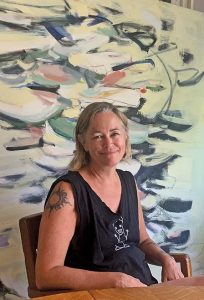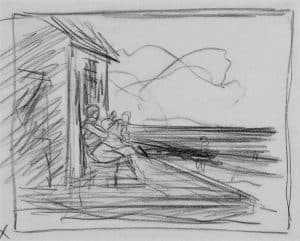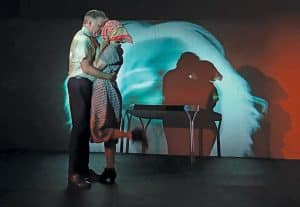Santaland #6
by Lee Roscoe
Is it a wish, or a dream of something barely seen; a suggestion, a whisper of something that could be, or was in memory? Susan Mikula’s photographs all share this commonality of illusion, delusion, something not quite there, even if their subjects are very different. Whether with the sensual nude in After Reprimand, the weird mechanicals of a carousel in the Santaland series, or subjects not literally of the sea but rather metaphors for it—she creates a liminal mystery. Liminal as barely perceptible, liminal as a spiritual border, liminal as transitional zones in the study of water bodies.

Mikula will have a retrospective exhibition at the Mary Heaton Vorse House, Into the Light: A 30-Year Anthology, covering 30 years of her work and running concurrently with a solo show of new work, The Moons of Neptune, at the Rice Polak Gallery, where she is represented locally.
She discovered her métier in her 30s when she fell in love with an old Polaroid camera she found in a thrift store on Martha’s Vineyard. She calls herself the last of the Polaroid photographers.
Her father, a commercial airline pilot, was also a photographer. “He would photograph your crash site or your hotel or your hobby store, [so] having a family which welcomed art made doing it seem possible.” Previously a writer, she quit trying to sell her short stories and turned to learning everything she could about Polaroids, intrigued as much with the mechanics as with the outcome they produce, and stressing the two are linked, something her father taught her. Though he shot with a “beautiful Rolleiflex” he also took Polaroids, and she recalls their chemical scent, and the surprises when they developed.
“I love Polaroids because they make unique positives, and that all the cameras are different,” she says, commenting that some lenses are not as good as others within just one line, because the technicians who put them together varied in skill. She now has about 25 cameras and knows each of them intimately. She likes SX70s and SX 70 alphas for general work, Spectras for a wide format, 600 SLRs for a wider light range. She uses old film, and she knows what colors will stay, which drop out. “With all art there are happy accidents, but part of getting a happy accident is knowing your equipment and materials.”
The mastery of material “strikes to the center of what I am trying to do,” she says. “I really take a lot of inspiration from painters. They are clear about their artistic responsibility, where it stops and where the viewer’s responsibility begins. I think [Hans] Hoffman put it that he would worry about everything from the canvas back.” But the viewer should respond from the face of the Polaroid forward.
The viewer’s perception is what she strives to evoke with her stylistic choices. Like El Greco there is a tilt in vision, in Mikula’s case, an out of focus, astigmatic tableau. “That’s how I see things. I look at my subject and I manipulate the focus on the camera to get exactly what I want. That may sound vain, but I make the decision because I decide it is right for that moment.” The style she says is “a way in, a way to deconstruct the scene, so I can get inside it. And I hope that is true for the viewer. I rather you see something from your past, from your mind, from your life, from your dreams, rather than from a remove.”

The Cape’s many entropic houses may have influenced this deconstructionist vision. As her partner since 1999, broadcaster Rachel Maddow, dryly noted when first introduced to the Cape, where they live now when not in western Massachusetts, “The houses here are not in good repair.”
A quintessential Mikula is Moons of Neptune, Galatea 1, featuring a washed-out lifeguard shack with glistering splats of light sanctifying it. Part of a series shot over the past two years especially for Rice Polak Gallery, Mikula wanted to pay tribute to the Cape’s inspirations, “not as other people might,” but to render “timeless, iconic, symbols, imagery for a place I find beautiful, mysterious, and romantic in the true sense,” she says. For all her work “a throughline is light; time of day is as important as where I shoot,” she adds.
Her subjects come to her in many ways. One series, On the Cruising Cloud/The Interdicted Land was shot for the U.S. government in Texas, about the border between it and Mexico. Before shooting, she says she “had to visit, think about, read about this a great deal.” Another series, Santaland, is of a real place she discovered while side-tripping in Vermont on a visit to her late mother. It encapsulates Mikula’s take on our species. “I think about us as humans in all our delicious, varied ways of being.” She delights that a Santa would wander off from a tiny train for a cigarette in the middle of July and that this Christmas place was, astonishingly, open in the summer, as a look at how “we humans don’t make sense in all ‘our fine peculiarities.’”
The Vorse House includes some of these amongst the 70 or 80 pieces, many of which are as large as four by four feet. The small Polaroids (which she likens to living creatures) are scanned in New York by a specialist, who enlarges them to very high resolution, with proofs for Mikula to find the one that best represents her original. They may be printed with dye sublimation on aluminum or by other methods onto a variety of special papers; the complex techniques avoid the polluting toxins of the dark room.
“I am so excited,” Mikula says. Excited to see her work through a new curator’s eyes at the Vorse, and to again work with one of the gallerists who represents her, Marla Rice at Rice Polak, because Marla’s way of seeing art thrills her. “It is very kind of people to show your art.”
Susan Mikula’s work is currently on view at the Mary Heaton Vorse House, 466 Commercial St., Provincetown, August 10 – September 10 with a cocktail reception on Thursday, August 10, 5 – 7 p.m. Her exhibition at Rice Polak Gallery, 430 Commercial St., is on view August 17 – 30, with an opening reception there on Friday, August 18, 7 p.m. Ricepolakgallery.com











